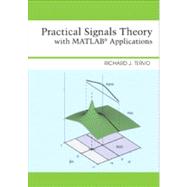
Note: Supplemental materials are not guaranteed with Rental or Used book purchases.
Purchase Benefits
What is included with this book?
Richard J. Tervo is the author of Practical Signals Theory with MATLAB Applications, published by Wiley.
0.2 List of Acronyms ix
1. Introduction to Signals and Systems 1
1.1 Introduction 2
1.2 Introduction to Signal Manipulation 4
1.3 A Few Useful Signals 11
1.4 The Sinusoidal Signal 20
1.5 Useful Hints and Help with MATLAB 29
1.6 Conclusions 31
1.7 End of Chapter Exercises 31
2. Classification of Signals 37
2.1 Introduction 38
2.2 Periodic Signals 38
2.3 Odd and Even Signals 46
2.4 Energy and Power Signals 54
2.5 Complex Signals 61
2.6 Discrete Time Signals 65
2.7 Digital Signals 67
2.8 Random Signals 68
2.9 Useful Hints and Help with MATLAB 69
2.10 Conclusions 71
2.11 End of Chapter Exercises 72
3. Linear Systems 79
3.1 Introduction 80
3.2 Definition of a Linear System 80
3.3 Linear System Response Function h(t) 87
3.4 Convolution 87
3.5 Determining h(t) in an Unknown System 103
3.6 Causality 107
3.7 Combined Systems 108
3.8 } Convolution and Random Numbers 110
3.9 Useful Hints and Help with MATLAB 112
3.10 Chapter Summary 113
3.11 Conclusions 114
3.12 End of Chapter Exercises 114
4. The Fourier Series 120
4.1 Introduction 121
4.2 Expressing Signals by Components 121
4.3 Part One - Orthogonal Signals 127
4.4 Orthogonality 127
4.5 Part Two - The Fourier Series 140
4.6 Computing Fourier Series Components 143
4.7 Fundamental Frequency Component 145
4.8 Practical Harmonics 149
4.9 Odd and Even Square Waves 151
4.10 Gibb's Phenomenon 155
4.11 Setting-Up the Fourier Series Calculation 156
4.12 Some Common Fourier Series 162
4.13 Part Three: The Complex Fourier Series 163
4.14 The Complex Fourier Series 164
4.15 Complex Fourier Series Components 171
4.16 Properties of the Complex Fourier Series 180
4.17 Analysis of a DC Power Supply 181
4.18 The Fourier Series with MATLAB 189
4.19 Conclusions; 196
4.20 End of Chapter Exercises 198
5. The Fourier Transform 207
5.1 Introduction 208
5.2 Properties of the Fourier Transform 215
5.3 The Rectangle Signal 219
5.4 The Sinc Function 221
5.5 Signal Manipulations: Time and Frequency 227
5.6 Fourier Transform Pairs 238
5.7 Rapid Changes vs High Frequencies 240
5.8 Conclusions 243
5.9 End of Chapter Exercises 245
6. Practical Fourier Transforms 250
6.1 Introduction 250
6.2 Convolution: Time and Frequency 251
6.3 Transfer Function of a Linear System 256
6.4 Energy in Signals: Parseval's Theorem for the Fourier Transform 259
6.5 Data Smoothing and the Frequency Domain 260
6.6 Ideal Filters 262
6.7 A Real Lowpass Filter 266
6.8 The Modulation Theorem 272
6.9 Periodic Signals and the Fourier Transform 277
6.10 The Analog Spectrum Analyzer 282
6.11 Conclusions 282
6.12 End of Chapter Exercises 284
7. The Laplace Transform 292
7.1 Introduction 293
7.2 The Laplace Transform 294
7.3 Exploring the s-domain 297
7.4 Visualizing the Laplace Transform 306
7.5 Properties of the Laplace Transform 325
7.6 Differential Equations 326
7.7 Laplace Transform Pairs 329
7.8 Circuit Analysis with the Laplace Transform 331
7.9 State Variable Analysis 347
7.10 Conclusion 358
7.11 End of Chapter Exercises 358
8. Discrete Signals 368
8.1 Introduction 368
8.2 Discrete Time vs Continuous Time Signals 369
8.3 A Discrete Time Signal 371
8.4 Data Collection and Sampling Rate 371
8.5 Introduction to Digital Filtering 388
8.6 Illustrative Examples 400
8.7 Discrete Time Filtering with MATLAB 411
8.8 Conclusions 413
8.9 End of Chapter Exercises 415
9. The z-Transform 420
9.1 Introduction 420
9.2 The z-Transform 421
9.3 Calculating the z-Transform 426
9.4 A Discrete Time Laplace Transform 433
9.5 Properties of the z-Transform 436
9.6 z-Transform Pairs 436
9.7 Transfer Function of a Discrete Linear System 437
9.8 MATLAB Analysis with the z-transform 437
9.9 Digital Filtering - FIR Filter 444
9.10 Digital Filtering - IIR Filter 451
9.11 Conclusions 456
9.12 End of Chapter Exercises 458
10. Introduction to Communications 463
10.1 Introduction 464
10.2 Amplitude Modulation 468
10.3 Suppressed Carrier Transmission 479
10.4 Superheterodyne Receiver 483
10.5 Digital Communications 489
10.6 Phase Shift Keying 495
10.7 Conclusions 498
10.8 End of Chapter Exercises 499
A. The Illustrated Fourier Transform 501
B. The Illustrated Laplace Transform 510
C. The Illustrated z-Transform 518
D. MATLAB Reference Guide 526
E. Reference Tables 537
The New copy of this book will include any supplemental materials advertised. Please check the title of the book to determine if it should include any access cards, study guides, lab manuals, CDs, etc.
The Used, Rental and eBook copies of this book are not guaranteed to include any supplemental materials. Typically, only the book itself is included. This is true even if the title states it includes any access cards, study guides, lab manuals, CDs, etc.